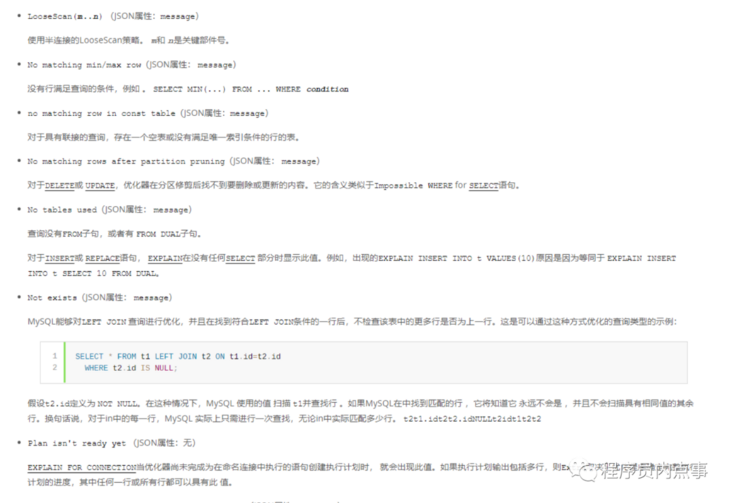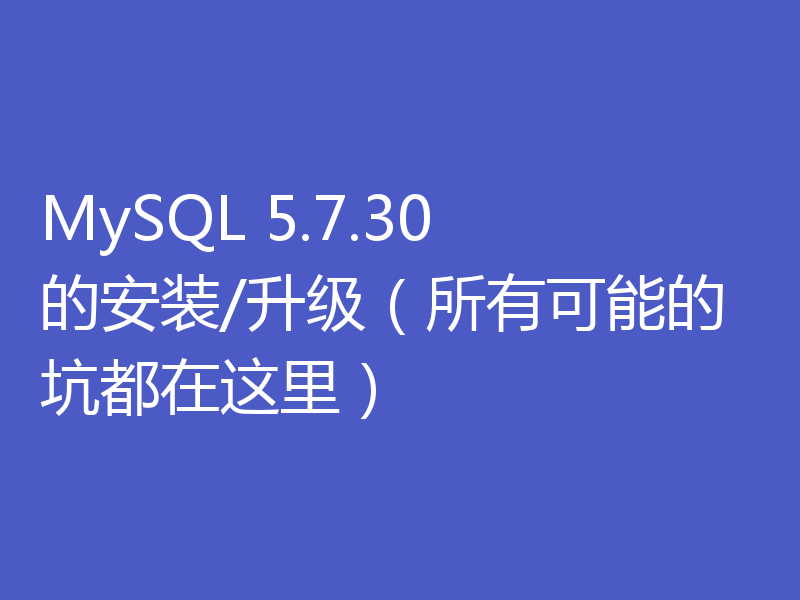Explain-执行计划
来源:SegmentFault
2023-01-20 17:11:03
0浏览
收藏
有志者,事竟成!如果你在学习数据库,那么本文《Explain-执行计划》,就很适合你!文章讲解的知识点主要包括MySQL、数据库,若是你对本文感兴趣,或者是想搞懂其中某个知识点,就请你继续往下看吧~
Explain有什么用
当
Explain与
SQL语句一起使用时,
MySQL会显示来自优化器关于SQL执行的信息。也就是说,
MySQL解释了它将如何处理该语句,包括如何连接表以及什么顺序连接表等。
- 表的加载顺序
-
sql
的查询类型 - 可能用到哪些索引,哪些索引又被实际使用
- 表与表之间的引用关系
- 一个表中有多少行被优化器查询 .....
Explain有哪些信息
Explain执行计划包含字段信息如下:分别是
id、
select_type、
table、
partitions、
type、
possible_keys、
key、
key_len、
ref、
rows、
filtered、
Extra12个字段。

SQL示例,详细的解读每个字段以及每个字段中不同参数的含义,以下所有示例数据库版本为
MySQL.5.7.17。
mysql> select version() from dual; +------------+ | version() | +------------+ | 5.7.17-log | +------------+
我们创建三张表
one、
two、
three,表之间的关系
one.two_id = two.two_id AND two.three_id = three.three_id。
Explain执行计划详解
一、id
id::表示查询中执行select子句或者操作表的顺序,
id的值越大,代表优先级越高,越先执行。
id大致会出现 3种情况:
1、id
相同
看到三条记录的
id都相同,可以理解成这三个表为一组,具有同样的优先级,执行顺序由上而下,具体顺序由优化器决定。
mysql> EXPLAIN SELECT * FROM one o,two t, three r WHERE o.two_id = t.two_id AND t.three_id = r.three_id; +----+-------------+-------+------------+--------+---------------+---------+---------+----------------------+------+----------+----------------------------------------------------+ | id | select_type | table | partitions | type | possible_keys | key | key_len | ref | rows | filtered | Extra | +----+-------------+-------+------------+--------+---------------+---------+---------+----------------------+------+----------+----------------------------------------------------+ | 1 | SIMPLE | o | NULL | ALL | NULL | NULL | NULL | NULL | 2 | 100 | NULL | | 1 | SIMPLE | t | NULL | ALL | PRIMARY | NULL | NULL | NULL | 2 | 50 | Using where; Using join buffer (Block Nested Loop) | | 1 | SIMPLE | r | NULL | eq_ref | PRIMARY | PRIMARY | 4 | xin-slave.t.three_id | 1 | 100 | NULL | +----+-------------+-------+------------+--------+---------------+---------+---------+----------------------+------+----------+----------------------------------------------------+
2、id
不同
如果我们的
SQL中存在子查询,那么
id的序号会递增,
id值越大优先级越高,越先被执行 。当三个表依次嵌套,发现最里层的子查询
id最大,最先执行。
mysql> EXPLAIN select * from one o where o.two_id = (select t.two_id from two t where t.three_id = (select r.three_id from three r where r.three_name='我是第三表2')); +----+-------------+-------+------------+------+---------------+------+---------+------+------+----------+-------------+ | id | select_type | table | partitions | type | possible_keys | key | key_len | ref | rows | filtered | Extra | +----+-------------+-------+------------+------+---------------+------+---------+------+------+----------+-------------+ | 1 | PRIMARY | o | NULL | ALL | NULL | NULL | NULL | NULL | 2 | 50 | Using where | | 2 | SUBQUERY | t | NULL | ALL | NULL | NULL | NULL | NULL | 2 | 50 | Using where | | 3 | SUBQUERY | r | NULL | ALL | NULL | NULL | NULL | NULL | 2 | 50 | Using where | +----+-------------+-------+------------+------+---------------+------+---------+------+------+----------+-------------+
3、以上两种同时存在
将上边的
SQL稍微修改一下,增加一个子查询,发现
id的以上两种同时存在。相同
id划分为一组,这样就有三个组,同组的从上往下顺序执行,不同组
id值越大,优先级越高,越先执行。
mysql> EXPLAIN select * from one o where o.two_id = (select t.two_id from two t where t.three_id = (select r.three_id from three r where r.three_name='我是第三表2')) AND o.one_id in(select one_id from one where o.one_name="我是第一表2"); +----+-------------+-------+------------+--------+---------------+---------+---------+--------------------+------+----------+-------------+ | id | select_type | table | partitions | type | possible_keys | key | key_len | ref | rows | filtered | Extra | +----+-------------+-------+------------+--------+---------------+---------+---------+--------------------+------+----------+-------------+ | 1 | PRIMARY | o | NULL | ALL | PRIMARY | NULL | NULL | NULL | 2 | 50 | Using where | | 1 | PRIMARY | one | NULL | eq_ref | PRIMARY | PRIMARY | 4 | xin-slave.o.one_id | 1 | 100 | Using index | | 2 | SUBQUERY | t | NULL | ALL | NULL | NULL | NULL | NULL | 2 | 50 | Using where | | 3 | SUBQUERY | r | NULL | ALL | NULL | NULL | NULL | NULL | 2 | 50 | Using where | +----+-------------+-------+------------+--------+---------------+---------+---------+--------------------+------+----------+-------------+
二、select_type
select_type:表示
select查询的类型,主要是用于区分各种复杂的查询,例如:
普通查询、
联合查询、
子查询等。
1、SIMPLE
SIMPLE:表示最简单的 select 查询语句,也就是在查询中不包含子查询或者
union交并差集等操作。
2、PRIMARY
PRIMARY:当查询语句中包含任何复杂的子部分,最外层查询则被标记为
PRIMARY。
3、SUBQUERY
SUBQUERY:当
select或
where列表中包含了子查询,该子查询被标记为:
SUBQUERY。
4、DERIVED
DERIVED:表示包含在
from子句中的子查询的select,在我们的
from列表中包含的子查询会被标记为
derived。
5、UNION
UNION:如果
union后边又出现的
select语句,则会被标记为
union;若
union包含在
from子句的子查询中,外层
select将被标记为
derived。
6、UNION RESULT
UNION RESULT:代表从
union的临时表中读取数据,而
table列的
<union1></union1>表示用第一个和第四个
select的结果进行
union操作。
mysql> EXPLAIN select t.two_name, ( select one.one_id from one) o from (select two_id,two_name from two where two_name ='') t union (select r.three_name,r.three_id from three r); +------+--------------+------------+------------+-------+---------------+---------+---------+------+------+----------+-----------------+ | id | select_type | table | partitions | type | possible_keys | key | key_len | ref | rows | filtered | Extra | +------+--------------+------------+------------+-------+---------------+---------+---------+------+------+----------+-----------------+ | 1 | PRIMARY | two | NULL | ALL | NULL | NULL | NULL | NULL | 2 | 50 | Using where | | 2 | SUBQUERY | one | NULL | index | NULL | PRIMARY | 4 | NULL | 2 | 100 | Using index | | 4 | UNION | r | NULL | ALL | NULL | NULL | NULL | NULL | 2 | 100 | NULL | | NULL | UNION RESULT | <union1> | NULL | ALL | NULL | NULL | NULL | NULL | NULL | NULL | Using temporary | +------+--------------+------------+------------+-------+---------------+---------+---------+------+------+----------+-----------------+</union1>
三、table
查询的表名,并不一定是真实存在的表,有别名显示别名,也可能为临时表,例如上边的
DERIVED、
<union1></union1>等。
四、partitions
查询时匹配到的分区信息,对于非分区表值为
NULL,当查询的是分区表时,
partitions显示分区表命中的分区情况。
+----+-------------+----------------+---------------------------------+-------+---------------+---------+---------+------+------+----------+-------------+ | id | select_type | table | partitions | type | possible_keys | key | key_len | ref | rows | filtered | Extra | +----+-------------+----------------+---------------------------------+-------+---------------+---------+---------+------+------+----------+-------------+ | 1 | SIMPLE | one | p201801,p201802,p201803,p300012 | index | NULL | PRIMARY | 9 | NULL | 3 | 100 | Using index | +----+-------------+----------------+---------------------------------+-------+---------------+---------+---------+------+------+----------+-------------+
五、type
type:查询使用了何种类型,它在
SQL优化中是一个非常重要的指标,以下性能从好到坏依次是:
system>
const>
eq_ref>
ref>
ref_or_null>
index_merge>
unique_subquery>
index_subquery>
range>
index>
ALL
1、system
system: 当表仅有一行记录时(系统表),数据量很少,往往不需要进行磁盘IO,速度非常快。
2、const
const:表示查询时命中
primary key主键或者
unique唯一索引,或者被连接的部分是一个常量(
const)值。这类扫描效率极高,返回数据量少,速度非常快。
mysql> EXPLAIN SELECT * from three where three_id=1; +----+-------------+-------+------------+-------+---------------+---------+---------+-------+------+----------+-------+ | id | select_type | table | partitions | type | possible_keys | key | key_len | ref | rows | filtered | Extra | +----+-------------+-------+------------+-------+---------------+---------+---------+-------+------+----------+-------+ | 1 | SIMPLE | three | NULL | const | PRIMARY | PRIMARY | 4 | const | 1 | 100 | NULL | +----+-------------+-------+------------+-------+---------------+---------+---------+-------+------+----------+-------+
3、eq_ref
eq_ref:查询时命中主键
primary key或者
unique key索引,
type就是
eq_ref。
mysql> EXPLAIN select o.one_name from one o ,two t where o.one_id = t.two_id ; +----+-------------+-------+------------+--------+---------------+----------+---------+--------------------+------+----------+-------------+ | id | select_type | table | partitions | type | possible_keys | key | key_len | ref | rows | filtered | Extra | +----+-------------+-------+------------+--------+---------------+----------+---------+--------------------+------+----------+-------------+ | 1 | SIMPLE | o | NULL | index | PRIMARY | idx_name | 768 | NULL | 2 | 100 | Using index | | 1 | SIMPLE | t | NULL | eq_ref | PRIMARY | PRIMARY | 4 | xin-slave.o.one_id | 1 | 100 | Using index | +----+-------------+-------+------------+--------+---------------+----------+---------+--------------------+------+----------+-------------+
4、ref
ref:区别于
eq_ref,
ref表示使用非唯一性索引,会找到很多个符合条件的行。
mysql> select o.one_id from one o where o.one_name = "xin" ; +--------+ | one_id | +--------+ | 1 | | 3 | +--------+ --->sql mysql> EXPLAIN select o.one_id from one o where o.one_name = "xin" ; +----+-------------+-------+------------+------+---------------+----------+---------+-------+------+----------+-------------+ | id | select_type | table | partitions | type | possible_keys | key | key_len | ref | rows | filtered | Extra | +----+-------------+-------+------------+------+---------------+----------+---------+-------+------+----------+-------------+ | 1 | SIMPLE | o | NULL | ref | idx_name | idx_name | 768 | const | 1 | 100 | Using index | +----+-------------+-------+------------+------+---------------+----------+---------+-------+------+----------+-------------+
5、ref_or_null
ref_or_null:这种连接类型类似于 ref,区别在于
MySQL会额外搜索包含
NULL值的行。
mysql> EXPLAIN select o.one_id from one o where o.one_name = "xin" OR o.one_name IS NULL; +----+-------------+-------+------------+-------------+---------------+----------+---------+-------+------+----------+--------------------------+ | id | select_type | table | partitions | type | possible_keys | key | key_len | ref | rows | filtered | Extra | +----+-------------+-------+------------+-------------+---------------+----------+---------+-------+------+----------+--------------------------+ | 1 | SIMPLE | o | NULL | ref_or_null | idx_name | idx_name | 768 | const | 3 | 100 | Using where; Using index | +----+-------------+-------+------------+-------------+---------------+----------+---------+-------+------+----------+--------------------------+
6、index_merge
index_merge:使用了索引合并优化方法,查询使用了两个以上的索引。
下边示例中同时使用到主键
one_id和 字段
one_name的
idx_name索引 。
mysql> EXPLAIN select * from one o where o.one_id >1 and o.one_name ='xin'; +----+-------------+-------+------------+-------------+------------------+------------------+---------+------+------+----------+------------------------------------------------+ | id | select_type | table | partitions | type | possible_keys | key | key_len | ref | rows | filtered | Extra | +----+-------------+-------+------------+-------------+------------------+------------------+---------+------+------+----------+------------------------------------------------+ | 1 | SIMPLE | o | NULL | index_merge | PRIMARY,idx_name | idx_name,PRIMARY | 772,4 | NULL | 1 | 100 | Using intersect(idx_name,PRIMARY); Using where | +----+-------------+-------+------------+-------------+------------------+------------------+---------+------+------+----------+------------------------------------------------+
7、unique_subquery
unique_subquery:替换下面的
IN子查询,子查询返回不重复的集合。
value IN (SELECT primary_key FROM single_table WHERE some_expr)
8、index_subquery
index_subquery:区别于
unique_subquery,用于非唯一索引,可以返回重复值。
value IN (SELECT key_column FROM single_table WHERE some_expr)
9、range
range:使用索引选择行,仅检索给定范围内的行。简单点说就是针对一个有索引的字段,给定范围检索数据。在
where语句中使用
bettween...and、
、<pre class="brush:go;">>、
、<pre class="brush:go;">in等条件查询
type都是
range。
举个栗子:
three表中
three_id为唯一主键,
user_id普通字段未建索引。
mysql> EXPLAIN SELECT * from three where three_id BETWEEN 2 AND 3; +----+-------------+-------+------------+-------+---------------+---------+---------+------+------+----------+-------------+ | id | select_type | table | partitions | type | possible_keys | key | key_len | ref | rows | filtered | Extra | +----+-------------+-------+------------+-------+---------------+---------+---------+------+------+----------+-------------+ | 1 | SIMPLE | three | NULL | range | PRIMARY | PRIMARY | 4 | NULL | 1 | 100 | Using where | +----+-------------+-------+------------+-------+---------------+---------+---------+------+------+----------+-------------+
从结果中看到只有对设置了索引的字段,做范围检索
type才是
range。
mysql> EXPLAIN SELECT * from three where user_id BETWEEN 2 AND 3; +----+-------------+-------+------------+------+---------------+------+---------+------+------+----------+-------------+ | id | select_type | table | partitions | type | possible_keys | key | key_len | ref | rows | filtered | Extra | +----+-------------+-------+------------+------+---------------+------+---------+------+------+----------+-------------+ | 1 | SIMPLE | three | NULL | ALL | NULL | NULL | NULL | NULL | 3 | 33.33 | Using where | +----+-------------+-------+------------+------+---------------+------+---------+------+------+----------+-------------+
10、index
index:
Index与
ALL其实都是读全表,区别在于
index是遍历索引树读取,而
ALL是从硬盘中读取。
下边示例:
three_id为主键,不带
where条件全表查询 ,
type结果为
index。
mysql> EXPLAIN SELECT three_id from three ; +----+-------------+-------+------------+-------+---------------+---------+---------+------+------+----------+-------------+ | id | select_type | table | partitions | type | possible_keys | key | key_len | ref | rows | filtered | Extra | +----+-------------+-------+------------+-------+---------------+---------+---------+------+------+----------+-------------+ | 1 | SIMPLE | three | NULL | index | NULL | PRIMARY | 4 | NULL | 1 | 100 | Using index | +----+-------------+-------+------------+-------+---------------+---------+---------+------+------+----------+-------------+
11、ALL
ALL:将遍历全表以找到匹配的行,性能最差。
mysql> EXPLAIN SELECT * from two ; +----+-------------+-------+------------+------+---------------+------+---------+------+------+----------+-------+ | id | select_type | table | partitions | type | possible_keys | key | key_len | ref | rows | filtered | Extra | +----+-------------+-------+------------+------+---------------+------+---------+------+------+----------+-------+ | 1 | SIMPLE | two | NULL | ALL | NULL | NULL | NULL | NULL | 2 | 100 | NULL | +----+-------------+-------+------------+------+---------------+------+---------+------+------+----------+-------+
六、possible_keys
possible_keys:表示在
MySQL中通过哪些索引,能让我们在表中找到想要的记录,一旦查询涉及到的某个字段上存在索引,则索引将被列出,但这个索引并不定一会是最终查询数据时所被用到的索引。具体请参考上边的例子。
七、key
key:区别于
possible_keys,key是查询中实际使用到的索引,若没有使用索引,显示为
NULL。具体请参考上边的例子。
当type为index_merge时,可能会显示多个索引。
八、key_len
key_len:表示查询用到的索引长度(字节数),原则上长度越短越好 。
- 单列索引,那么需要将整个索引长度算进去;
- 多列索引,不是所有列都能用到,需要计算查询中实际用到的列。
注意:key_len只计算where条件中用到的索引长度,而排序和分组即便是用到了索引,也不会计算到key_len中。
九、ref
ref:常见的有:
const,
func,
null,字段名。
- 当使用常量等值查询,显示
const
, - 当关联查询时,会显示相应关联表的
关联字段
- 如果查询条件使用了
表达式
、函数
,或者条件列发生内部隐式转换,可能显示为func
- 其他情况
null
十、rows
rows:以表的统计信息和索引使用情况,估算要找到我们所需的记录,需要读取的行数。
这是评估
SQL性能的一个比较重要的数据,
mysql需要扫描的行数,很直观的显示
SQL性能的好坏,一般情况下
rows值越小越好。
mysql> EXPLAIN SELECT * from three; +----+-------------+-------+------------+------+---------------+------+---------+------+------+----------+-------+ | id | select_type | table | partitions | type | possible_keys | key | key_len | ref | rows | filtered | Extra | +----+-------------+-------+------------+------+---------------+------+---------+------+------+----------+-------+ | 1 | SIMPLE | three | NULL | ALL | NULL | NULL | NULL | NULL | 3 | 100 | NULL | +----+-------------+-------+------------+------+---------------+------+---------+------+------+----------+-------+
十一、filtered
filtered这个是一个百分比的值,表里符合条件的记录数的百分比。简单点说,这个字段表示存储引擎返回的数据在经过过滤后,剩下满足条件的记录数量的比例。
在
MySQL.5.7版本以前想要显示
filtered需要使用
explain extended命令。
MySQL.5.7后,默认
explain直接显示
partitions和
filtered的信息。
十二、Extra
Extra:不适合在其他列中显示的信息,
Explain中的很多额外的信息会在
Extra字段显示。
1、Using index
Using index:我们在相应的
select操作中使用了覆盖索引,通俗一点讲就是查询的列被索引覆盖,使用到覆盖索引查询速度会非常快,
SQl优化中理想的状态。
什么又是覆盖索引?
一条
SQL只需要通过索引就可以返回,我们所需要查询的数据(一个或几个字段),而不必通过二级索引,查到主键之后再通过主键查询整行数据(
select *)。
one_id表为主键
mysql> EXPLAIN SELECT one_id from one ; +----+-------------+-------+------------+-------+---------------+------------+---------+------+------+----------+-------------+ | id | select_type | table | partitions | type | possible_keys | key | key_len | ref | rows | filtered | Extra | +----+-------------+-------+------------+-------+---------------+------------+---------+------+------+----------+-------------+ | 1 | SIMPLE | one | NULL | index | NULL | idx_two_id | 5 | NULL | 3 | 100 | Using index | +----+-------------+-------+------------+-------+---------------+------------+---------+------+------+----------+-------------+
注意:想要使用到覆盖索引,我们在
select时只取出需要的字段,不可
select *,而且该字段建了索引。
mysql> EXPLAIN SELECT * from one ; +----+-------------+-------+------------+------+---------------+------+---------+------+------+----------+-------+ | id | select_type | table | partitions | type | possible_keys | key | key_len | ref | rows | filtered | Extra | +----+-------------+-------+------------+------+---------------+------+---------+------+------+----------+-------+ | 1 | SIMPLE | one | NULL | ALL | NULL | NULL | NULL | NULL | 3 | 100 | NULL | +----+-------------+-------+------------+------+---------------+------+---------+------+------+----------+-------+
2、Using where
Using where:查询时未找到可用的索引,进而通过
where条件过滤获取所需数据,但要注意的是并不是所有带
where语句的查询都会显示
Using where。
下边示例
create_time并未用到索引,
type为
ALL,即
MySQL通过全表扫描后再按
where条件筛选数据。
mysql> EXPLAIN SELECT one_name from one where create_time ='2020-05-18'; +----+-------------+-------+------------+------+---------------+------+---------+------+------+----------+-------------+ | id | select_type | table | partitions | type | possible_keys | key | key_len | ref | rows | filtered | Extra | +----+-------------+-------+------------+------+---------------+------+---------+------+------+----------+-------------+ | 1 | SIMPLE | one | NULL | ALL | NULL | NULL | NULL | NULL | 3 | 33.33 | Using where | +----+-------------+-------+------------+------+---------------+------+---------+------+------+----------+-------------+
3、Using temporary
Using temporary:表示查询后结果需要使用临时表来存储,一般在排序或者分组查询时用到。
mysql> EXPLAIN SELECT one_name from one where one_id in (1,2) group by one_name; +----+-------------+-------+------------+------+---------------+------+---------+------+------+----------+-------------+ | id | select_type | table | partitions | type | possible_keys | key | key_len | ref | rows | filtered | Extra | +----+-------------+-------+------------+------+---------------+------+---------+------+------+----------+-------------+ | 1 | SIMPLE | one | NULL | range| NULL | NULL | NULL | NULL | 3 | 33.33 | Using where; Using temporary; Using filesort | +----+-------------+-------+------------+------+---------------+------+---------+------+------+----------+-------------+
4、Using filesort
Using filesort:表示无法利用索引完成的排序操作,也就是
ORDER BY的字段没有索引,通常这样的SQL都是需要优化的。
mysql> EXPLAIN SELECT one_id from one ORDER BY create_time; +----+-------------+-------+------------+------+---------------+------+---------+------+------+----------+----------------+ | id | select_type | table | partitions | type | possible_keys | key | key_len | ref | rows | filtered | Extra | +----+-------------+-------+------------+------+---------------+------+---------+------+------+----------+----------------+ | 1 | SIMPLE | one | NULL | ALL | NULL | NULL | NULL | NULL | 3 | 100 | Using filesort | +----+-------------+-------+------------+------+---------------+------+---------+------+------+----------+----------------+
如果
ORDER BY字段有索引就会用到覆盖索引,相比执行速度快很多。
mysql> EXPLAIN SELECT one_id from one ORDER BY one_id; +----+-------------+-------+------------+-------+---------------+---------+---------+------+------+----------+-------------+ | id | select_type | table | partitions | type | possible_keys | key | key_len | ref | rows | filtered | Extra | +----+-------------+-------+------------+-------+---------------+---------+---------+------+------+----------+-------------+ | 1 | SIMPLE | one | NULL | index | NULL | PRIMARY | 4 | NULL | 3 | 100 | Using index | +----+-------------+-------+------------+-------+---------------+---------+---------+------+------+----------+-------------+
5、Using join buffer
Using join buffer:在我们联表查询的时候,如果表的连接条件没有用到索引,需要有一个连接缓冲区来存储中间结果。
先看一下有索引的情况:连接条件
one_name、
two_name都用到索引。
mysql> EXPLAIN SELECT one_name from one o,two t where o.one_name = t.two_name; +----+-------------+-------+------------+-------+---------------+----------+---------+----------------------+------+----------+--------------------------+ | id | select_type | table | partitions | type | possible_keys | key | key_len | ref | rows | filtered | Extra | +----+-------------+-------+------------+-------+---------------+----------+---------+----------------------+------+----------+--------------------------+ | 1 | SIMPLE | o | NULL | index | idx_name | idx_name | 768 | NULL | 3 | 100 | Using where; Using index | | 1 | SIMPLE | t | NULL | ref | idx_name | idx_name | 768 | xin-slave.o.one_name | 1 | 100 | Using index | +----+-------------+-------+------------+-------+---------------+----------+---------+----------------------+------+----------+--------------------------+
接下来删掉 连接条件
one_name、
two_name的字段索引。发现
Extra列变成
Using join buffer,
type均为全表扫描,这也是
SQL优化中需要注意的地方。
mysql> EXPLAIN SELECT one_name from one o,two t where o.one_name = t.two_name; +----+-------------+-------+------------+------+---------------+------+---------+------+------+----------+----------------------------------------------------+ | id | select_type | table | partitions | type | possible_keys | key | key_len | ref | rows | filtered | Extra | +----+-------------+-------+------------+------+---------------+------+---------+------+------+----------+----------------------------------------------------+ | 1 | SIMPLE | t | NULL | ALL | NULL | NULL | NULL | NULL | 2 | 100 | NULL | | 1 | SIMPLE | o | NULL | ALL | NULL | NULL | NULL | NULL | 3 | 33.33 | Using where; Using join buffer (Block Nested Loop) | +----+-------------+-------+------------+------+---------------+------+---------+------+------+----------+----------------------------------------------------+
6、Impossible where
Impossible where:表示在我们用不太正确的
where语句,导致没有符合条件的行。
mysql> EXPLAIN SELECT one_name from one WHERE 1=2; +----+-------------+-------+------------+------+---------------+------+---------+------+------+----------+------------------+ | id | select_type | table | partitions | type | possible_keys | key | key_len | ref | rows | filtered | Extra | +----+-------------+-------+------------+------+---------------+------+---------+------+------+----------+------------------+ | 1 | SIMPLE | NULL | NULL | NULL | NULL | NULL | NULL | NULL | NULL | NULL | Impossible WHERE | +----+-------------+-------+------------+------+---------------+------+---------+------+------+----------+------------------+
7、No tables used
No tables used:我们的查询语句中没有
FROM子句,或者有
FROM DUAL子句。
mysql> EXPLAIN select now(); +----+-------------+-------+------------+------+---------------+------+---------+------+------+----------+----------------+ | id | select_type | table | partitions | type | possible_keys | key | key_len | ref | rows | filtered | Extra | +----+-------------+-------+------------+------+---------------+------+---------+------+------+----------+----------------+ | 1 | SIMPLE | NULL | NULL | NULL | NULL | NULL | NULL | NULL | NULL | NULL | No tables used | +----+-------------+-------+------------+------+---------------+------+---------+------+------+----------+----------------+
Extra列的信息非常非常多,这里就不再一一列举了,详见
MySQL官方文档 :https://dev.mysql.com/doc/ref..._index_merge

文中关于mysql的知识介绍,希望对你的学习有所帮助!若是受益匪浅,那就动动鼠标收藏这篇《Explain-执行计划》文章吧,也可关注golang学习网公众号了解相关技术文章。
版本声明
本文转载于:SegmentFault 如有侵犯,请联系study_golang@163.com删除
 批发分销ERP系统可以帮助企业解决什么问题?
批发分销ERP系统可以帮助企业解决什么问题?
- 上一篇
- 批发分销ERP系统可以帮助企业解决什么问题?

- 下一篇
- MySQL 5.7.30 的安装/升级(所有可能的坑都在这里)
查看更多
最新文章
-

- 数据库 · MySQL | 1小时前 |
- mysql数据库基础命令 新手必学的mysql操作指令合集
- 233浏览 收藏
-

- 数据库 · MySQL | 10小时前 | mysql 聚合函数
- mysql数据库中聚合函数的功能_mysql数据库中统计函数的作用
- 385浏览 收藏
-

- 数据库 · MySQL | 1天前 | MySql锁 数据库锁
- MySQL锁机制原理与类型解析
- 412浏览 收藏
-

- 数据库 · MySQL | 3天前 |
- 主键与唯一键区别详解及选择技巧
- 320浏览 收藏
-

- 数据库 · MySQL | 6天前 |
- MySQLSQL执行过程全解析
- 432浏览 收藏
-

- 数据库 · MySQL | 1星期前 |
- MySQL性能监控设置与关键指标解析
- 108浏览 收藏
-

- 数据库 · MySQL | 1星期前 |
- MySQL权限管理与设置全攻略
- 315浏览 收藏
-

- 数据库 · MySQL | 1星期前 |
- MySQL批量插入数据技巧详解
- 358浏览 收藏
-

- 数据库 · MySQL | 1星期前 |
- MySQLgroupby分组查询全解析
- 113浏览 收藏
-

- 数据库 · MySQL | 1星期前 |
- MySQL优化Join查询技巧与常用策略解析
- 128浏览 收藏
-

- 数据库 · MySQL | 2星期前 |
- MySQL中AS的作用及使用示例
- 460浏览 收藏
-

- 数据库 · MySQL | 2星期前 |
- MySQL数值函数与数学计算全解析
- 349浏览 收藏
查看更多
课程推荐
-

- 前端进阶之JavaScript设计模式
- 设计模式是开发人员在软件开发过程中面临一般问题时的解决方案,代表了最佳的实践。本课程的主打内容包括JS常见设计模式以及具体应用场景,打造一站式知识长龙服务,适合有JS基础的同学学习。
- 543次学习
-

- GO语言核心编程课程
- 本课程采用真实案例,全面具体可落地,从理论到实践,一步一步将GO核心编程技术、编程思想、底层实现融会贯通,使学习者贴近时代脉搏,做IT互联网时代的弄潮儿。
- 516次学习
-

- 简单聊聊mysql8与网络通信
- 如有问题加微信:Le-studyg;在课程中,我们将首先介绍MySQL8的新特性,包括性能优化、安全增强、新数据类型等,帮助学生快速熟悉MySQL8的最新功能。接着,我们将深入解析MySQL的网络通信机制,包括协议、连接管理、数据传输等,让
- 500次学习
-

- JavaScript正则表达式基础与实战
- 在任何一门编程语言中,正则表达式,都是一项重要的知识,它提供了高效的字符串匹配与捕获机制,可以极大的简化程序设计。
- 487次学习
-

- 从零制作响应式网站—Grid布局
- 本系列教程将展示从零制作一个假想的网络科技公司官网,分为导航,轮播,关于我们,成功案例,服务流程,团队介绍,数据部分,公司动态,底部信息等内容区块。网站整体采用CSSGrid布局,支持响应式,有流畅过渡和展现动画。
- 485次学习
查看更多
AI推荐
-

- ChatExcel酷表
- ChatExcel酷表是由北京大学团队打造的Excel聊天机器人,用自然语言操控表格,简化数据处理,告别繁琐操作,提升工作效率!适用于学生、上班族及政府人员。
- 3371次使用
-

- Any绘本
- 探索Any绘本(anypicturebook.com/zh),一款开源免费的AI绘本创作工具,基于Google Gemini与Flux AI模型,让您轻松创作个性化绘本。适用于家庭、教育、创作等多种场景,零门槛,高自由度,技术透明,本地可控。
- 3581次使用
-

- 可赞AI
- 可赞AI,AI驱动的办公可视化智能工具,助您轻松实现文本与可视化元素高效转化。无论是智能文档生成、多格式文本解析,还是一键生成专业图表、脑图、知识卡片,可赞AI都能让信息处理更清晰高效。覆盖数据汇报、会议纪要、内容营销等全场景,大幅提升办公效率,降低专业门槛,是您提升工作效率的得力助手。
- 3612次使用
-

- 星月写作
- 星月写作是国内首款聚焦中文网络小说创作的AI辅助工具,解决网文作者从构思到变现的全流程痛点。AI扫榜、专属模板、全链路适配,助力新人快速上手,资深作者效率倍增。
- 4742次使用
-

- MagicLight
- MagicLight.ai是全球首款叙事驱动型AI动画视频创作平台,专注于解决从故事想法到完整动画的全流程痛点。它通过自研AI模型,保障角色、风格、场景高度一致性,让零动画经验者也能高效产出专业级叙事内容。广泛适用于独立创作者、动画工作室、教育机构及企业营销,助您轻松实现创意落地与商业化。
- 3986次使用
查看更多
相关文章
-
- golang MySQL实现对数据库表存储获取操作示例
- 2022-12-22 499浏览
-
- 搞一个自娱自乐的博客(二) 架构搭建
- 2023-02-16 244浏览
-
- B-Tree、B+Tree以及B-link Tree
- 2023-01-19 235浏览
-
- mysql面试题
- 2023-01-17 157浏览
-
- MySQL数据表简单查询
- 2023-01-10 101浏览



